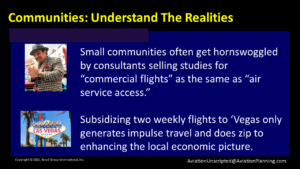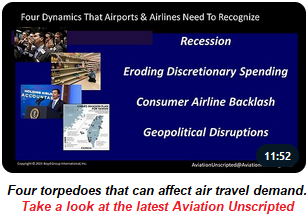Israel/Hamas Example:
An Urgent Message For USA Airports
“To a trained terrorist, our airports have the security of a laundromat.”
Mike Boyd quoted in the Wall Street Journal, July 1997
“There is the potential for multiple hijackings of flights at Boston/Logan.”
FAA Security Red Team Inspector Brian Sullivan in an urgent report, May 2001.
These are just a couple of observations made by many people before 9/11 regarding the state of airport security, particularly from the FAA’s own security teams.
‘Course, the powers in charge, from an incompetent FAA Administrator, Jane Garvey, to a prestigious US senator, John Kerry, ignored the warnings from these FAA security professional. Persecuted some of them, actually, even after they were proved right.
Reaction Is Not Security. Where Homeland Security and TSA fails Security is a matter of anticipating threats, protecting citizens and the infrastructure they rely upon, and being able to quickly remediate the effects of an attack.
It is a logical fear the none of this is fully in place in our aviation system.
Let’s face it, things like shoes off in security lines, liquids restricted, coats into the scanner, etc., were all reactions to various security threats after events took place somewhere else. They were not due to professional, anticipative security planning and expertise.
Professional security forethought wasn’t involved. Ignore this at our peril: We are not engaged in active, aggressive security planning at our airports. We could be at a point like Israel found a few days ago.
Protect Our Way of Life. Instead of Just Looking For Oversize Bottles of Grecian Formula. Then there is the critical issue of remediation in the event of a security breach. Programs to reduce the infrastructural damage and public dangers after an event. But the chances that this is a part of the gong show of pointy-object detection at our airports is near zero. You can take it to the bank that there is no serious scenario planning whatsoever.
 From events over the past 20 years, the directions seems to be to just run and evacuate. Not encouraging. The performance of Alexandro Mayorkas, the Secretary of Homeland Security, is alarming. His basic idea of “security systems” is allowing thousands of completely undocumented and unvetted people from all over the world to be transported by bad actors to our southern borders, where they are being freely allowed entry to the USA.
From events over the past 20 years, the directions seems to be to just run and evacuate. Not encouraging. The performance of Alexandro Mayorkas, the Secretary of Homeland Security, is alarming. His basic idea of “security systems” is allowing thousands of completely undocumented and unvetted people from all over the world to be transported by bad actors to our southern borders, where they are being freely allowed entry to the USA.
They are rewarded with money and cell phones, and then transported to points across the nation. We have political theater. One dangerous observation is an increase in “refugees” from China coming across the Mexico boarder – with reportedly many appearing to be fit and able young men, not poor refugees from Fujian or Zhengzhou. Trained, maybe. Fifth column, maybe?
Back at our airports, there are no plans in place beyond getting away from where a perceived threat takes place. The fiasco in a baggage claim area a few years ago at the FLL is one example (Google if you must.) No plan, no concept of crowd safety. People just ran. Some willy-nilly onto the active AOA according to reports. See, it didn’t take place in a supposedly “sterile” area. So, a security remediation or facility exit plan was, well, not needed.
Take a gander at congressional hearings involving Mayorkas. The man is an embarrassment and appears completely and arrogantly incompetent – which most of the participants in these political shows are very comfortable with. Gee, hundreds of people from Haiti show up at a small Mexican town along the Texas border, and nobody dares ask who got them there. Nope, it’s not an invasion, folks. Nothing to see here. Homeland Security has it under control.
Just like Jane Garvey and AVSEC policies did on 9/11.
Now with the lightning-fast strikes against civil targets in Israel, maybe it’s time to take a hard look at AVSEC in America. Naturally, the official response is that the TSA is in control, and all is well.
Sorta like the systems in place the day before 9/11.
Common Sense Security – Think Like A Terrorist. A couple of observations. The current approach at airports tends to be focused mostly on passenger security, with low focus on the security of the infrastructure.
What about the security of HVAC systems? Are all people working on the taxiway rehab intensely screened before entering the work site? Is any real consideration given to the trucks and vehicles taking equipment onto not only the AOA but non-sterile areas as well?
If a security threat or emergency takes place in concourse B, what is the plan to safely move people? What is the plan for concourse C? How about the air cargo facilities? Catering operations? What is the real security-awareness training of staff working at the airport?
Now, the usual toadies in the national media will rush to tell us that the administration has it all in hand. One appalling “national network correspondent” got screaming angry when I told him that we had a lot more to do in regard to AVSEC. Nope. See he’d interviewed the top people at the TSA, and was armed with all the “facts.”
Just like the assumptions about Jane Garvey’s AVSEC before 9/11.
Here’s the point: Aviation security is not just about finding C-4 in a Samsonite. It’s about protecting our way of life, including the systems on which we depend.
The extent and suddenness of what just happened in Israel should not be ignored. Assuming that Homeland Security has it under anticipative control is foolish.
Awareness is imperative. Thinking like a terrorist is the correct approach.
That’s not in place at the TSA.







